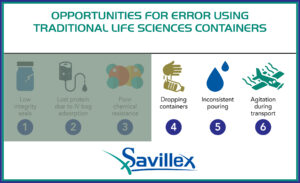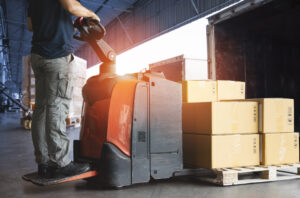The Problems With Traditional Life Sciences Containers (Part Two)

In the world of life sciences and medical research, containers play a crucial role in the storage, transportation, and preservation of various materials. These containers are used to store chemicals, biological samples, and other sensitive substances.
However, like any other aspect of scientific research, there are unique challenges associated with life sciences containers – many of which lead to an increased chance of error during crucial workflows. For one, these errors can lead to inaccurate data, rendering experiments and research findings unreliable. They can also create a hazardous or potentially unsafe environment, and can have a negative financial impact on the organizations that use them.
But what are the specific common problems that you should be on the lookout for when putting bottles, jars, vials, bags, and other life sciences containers into use? In this two-part blog series, we will discuss some of these challenges and explore potential solutions.
Here are three more potential pitfalls to keep an eye out for during your life sciences applications:

In part two of this blog series we will examine three of the six primary errors associated with the use of many life sciences containers on the market today. Our Purillex® line of Bottles, Jars, and Vials were designed with life sciences applications specifically in mind, and with the goal to greatly reduce or even eliminate these errors. Let’s get into the final three so we can gain a better idea of what to look out for.
4) Dropping Containers
Containers chosen for bulk drug substance storage and transport must be impact resistant while exhibiting container closure integrity and low leachables and extractables. They must also withstand autoclave sterilization, extreme temperatures, and be chemically resistant – especially due to the fact that the products they’re storing are of such high value.
PFA is a high-performing polymer that life sciences customers select for critical container needs due to its excellent impact resistance. Furthermore, while other polymers may weaken or deform when subjected to certain chemicals, temperatures, or processes, PFA offers a supreme level of reliability in these areas.
Savillex Purillex® PFA containers are the only choice for pharmaceutical process development personnel who need a container that has superior impact resistance when the product inside is so valuable. Their container closure system has a superior design, which ensures a better seal and better protection of contents even under blast freeze conditions. The identical fluoropolymer resin type and grade are used for both bottle and closure, and both bottle thread and closure are injection molded, ensuring precise fit and superior seal integrity without the need for a closure insert.
Purillex PFA containers undergo critical quality testing to ensure excellent impact resistance. Follow this link to learn more about freeze drop testing performed on our Purillex PFA Bottles: https://lnkd.in/g9YpHHwx
5) Inconsistent Pouring
Many containers used in Life Sciences applications are not properly designed to ensure consistent pouring of fluids. Certain materials, for example, cause liquids to adhere to their surfaces (especially more viscous liquids) – which can lead to loss of contents. Poor structural design can also lead to loss of pour control and uneven pouring.
Fluoropolymer bottles are used in a variety of Life Sciences applications, most notably for bulk drug storage in pharmaceutical manufacturing where every single drop of material is critical. Due to their non-stick properties, users can rest assured that liquids, no matter how viscous, do not adhere to the surface.
Fluoropolymer bottles also have a smooth surface which allows liquids to be poured out efficiently without concern of material hold up from the surface of the interior.
Savillex manufactures fluoropolymer bottles in PFA, FEP, or FEP with an ETFE closure using an innovative molding process that provides users with an excellent choice for containing critical materials in pharmaceutical manufacturing. The smooth inner neck design of Savillex fluoropolymer bottles also allows for more controlled pouring. Watch this YouTube video for a demonstration.
6) Agitation During Transport

While maintaining product integrity during transport and shipment is a priority for any business, it’s a particularly pressing challenge for life sciences and pharmaceutical companies due to the highly sensitive and valuable nature of the products.
For one, many of these products must remain at a specific temperature range at all times – which can become difficult when challenging shipping conditions arise. Exposure to temperatures outside of this range can potentially ruin the quality of these products.
Time is also a consideration, as many drugs and therapeutic agents also possess short half-lives. Inefficiencies in the supply chain or unexpected delays can render these products ineffective if deadlines aren’t met, which has a negative impact both financially and on end patient care.
Product damage and prolonged light exposure are just a couple more potential issues that can arise during life sciences shipping and transport. The durability and structural integrity of Purillex containers provide users with peace of mind during challenging conditions. Their wide temperature range helps protect your valuable contents in many environments, while their excellent Container Closure Integrity Testing (CCIT) and extractables/leachables testing performance will keep everything contained. Click here to view our CCIT results.
In conclusion, life sciences containers present unique challenges due to the nature of their contents and the stringent requirements for their storage and transportation. By addressing issues related to contamination, temperature control, durability, and organization, researchers and manufacturers can overcome these challenges and ensure the best possible outcomes in life sciences research. Harnessing innovative technologies and implementing robust protocols will pave the way for safer and more efficient container management in the field of life sciences.
Click here to view part one of this blog series.
Click here to learn more about our Purillex line of life sciences containers including Bottles, Jars, and Vials.



